I’ll make the inevitable Rolex comparison right up front. The Submariner is the iconic, always popular Rolex diver, while the technically superior Sea-Dweller (and its variants) take a bit of a back seat. In Omega’s world, the always popular Seamaster Diver 300M is comparable to the Submariner, while the Seamaster Planet Ocean is the technically superior diver that lives a bit in its shadow, just like the Sea-Dweller. 300 metres is generally reserved for saturation divers, so a watch that descends deeper is mostly for bragging rights. Raise your hand if you dive to 600 metres – or even much deeper for some of the collection’s latest releases, and it’s even crazier prototypes. For many, the cool factor alone is enough, and that was good enough for James Bond, so let’s dive into the Seamaster Planet Ocean’s fascinating history, a watch first released in 2005 and that celebrates its 20th anniversary this year… Who knows what Omega will do to pay homage to this important collection, if ever the brand is willing to do so (at least, that’s what we hope).
Early Omega Seamaster
The first Seamaster debuted in 1948, which was also the 100th anniversary of Omega (known as La Generale Watch Co. until 1903). It was more of a dress watch than a modern diver, marketed for town, sea, and country, but featured a rubber O-ring gasket for the crown developed during the war, and it successfully descended 62.5 metres during a 1955 Australian dive by Gordon McLean. It wouldn’t be until 1953 that Rolex launched the Submariner, possibly the first modern diver, followed by the Blancpain Fifty Fathoms and others. Both featured a rotating diver’s bezel and water-resistance up to 100 metres (technically 91 metres or fifty fathoms for Blancpain). To discover more about the history of the Seamaster collection, I invite you to take a look at the first episode of our Seamaster Chronicles series of videos.
 The original pair of Seamaster watches released in 1948
The original pair of Seamaster watches released in 1948
The Master Trio and Seamaster 300
In 1957, Omega introduced the Master series of watches – the Railmaster (CK2914) with significant magnetic resistance, the Speedmaster (CK2915) for timing motorsports and the Seamaster 300 (CK2913), Omega’s first true professional dive watch with a rotating bezel. The Seamaster 300 was a favourite of Jacques Cousteau (among other brands) and established the brand as a serious contender in the diving world. It was rated for 200 metres as that was the limit of the testing equipment, but Omega was confident it could descend to 300 metres (and chose that name accordingly).
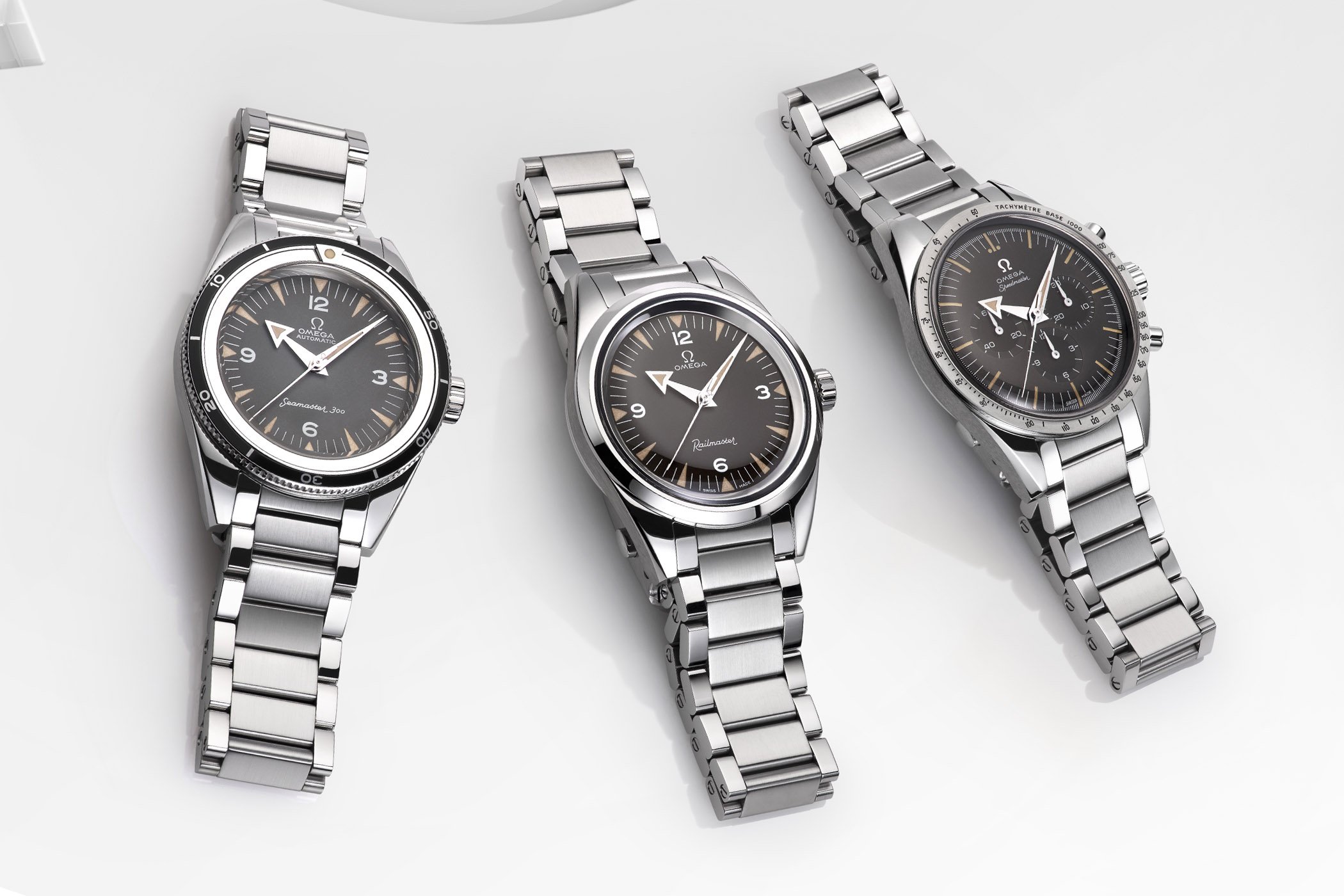

In 1970, Omega partnered with commercial diving firm COMEX (Compagnie Maritime d’Expertises) to produce the Seamaster 600 or Seamaster PloProf (plongeurs professionels or professional divers). Under the PloProf Research Program, a somewhat bizarre, asymmetrical monobloc case was developed that was so airtight that a helium escape valve wasn’t necessary. A few years later, the PloProf model known as The Grand could descend to 1,000 metres. Omega was really proving itself as an innovative leader in the diving space. There’s even a current PloProf model with a water-resistance of 1,200 metres, which follows the model’s relaunch in 2009.
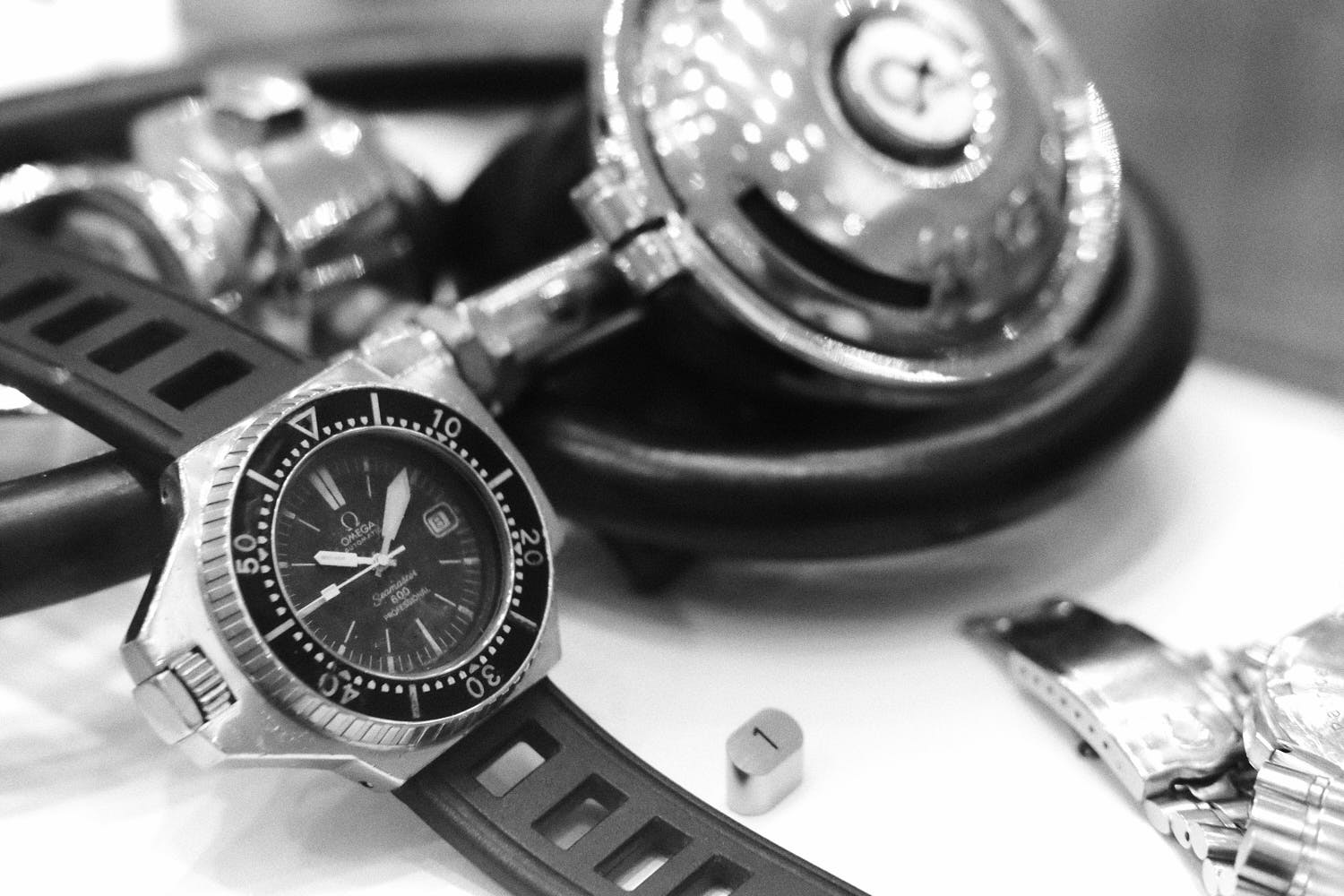

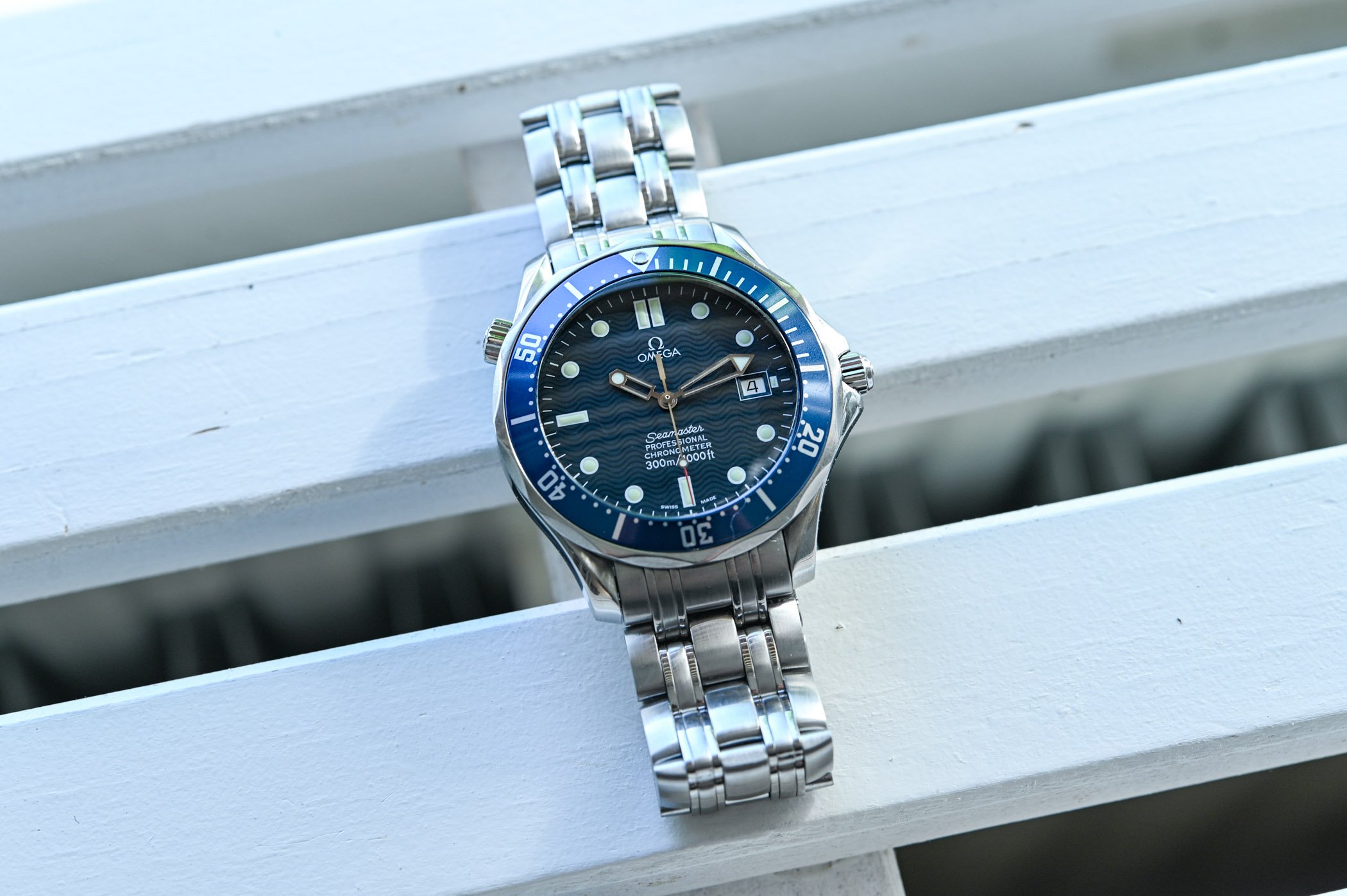

In 1993, the Seamaster Diver 300M succeeded the Seamaster 300 (technically a Seamaster 200M replacement) and became a James Bond favourite, starting with Pierce Brosnan’s Goldeneye in 1995. It also had an official 300-metre water-resistance rating via testing equipment and included a manual helium escape valve at 10 o’clock that resembled a second crown. It needed to be unscrewed before operation. Given the times, Bond’s Goldeneye watch was quartz powered, but early models also used 1109 and 1120 automatic calibres (based on ETA). In 2006, Daniel Craig took over as Bond in Casino Royale and sported a Seamaster Diver 300M with calibre 2500, which was based on the ETA 2892-A2 but modified with Omega’s Co-Axial escapement (a year after this movement hit the Seamaster Planet Ocean).
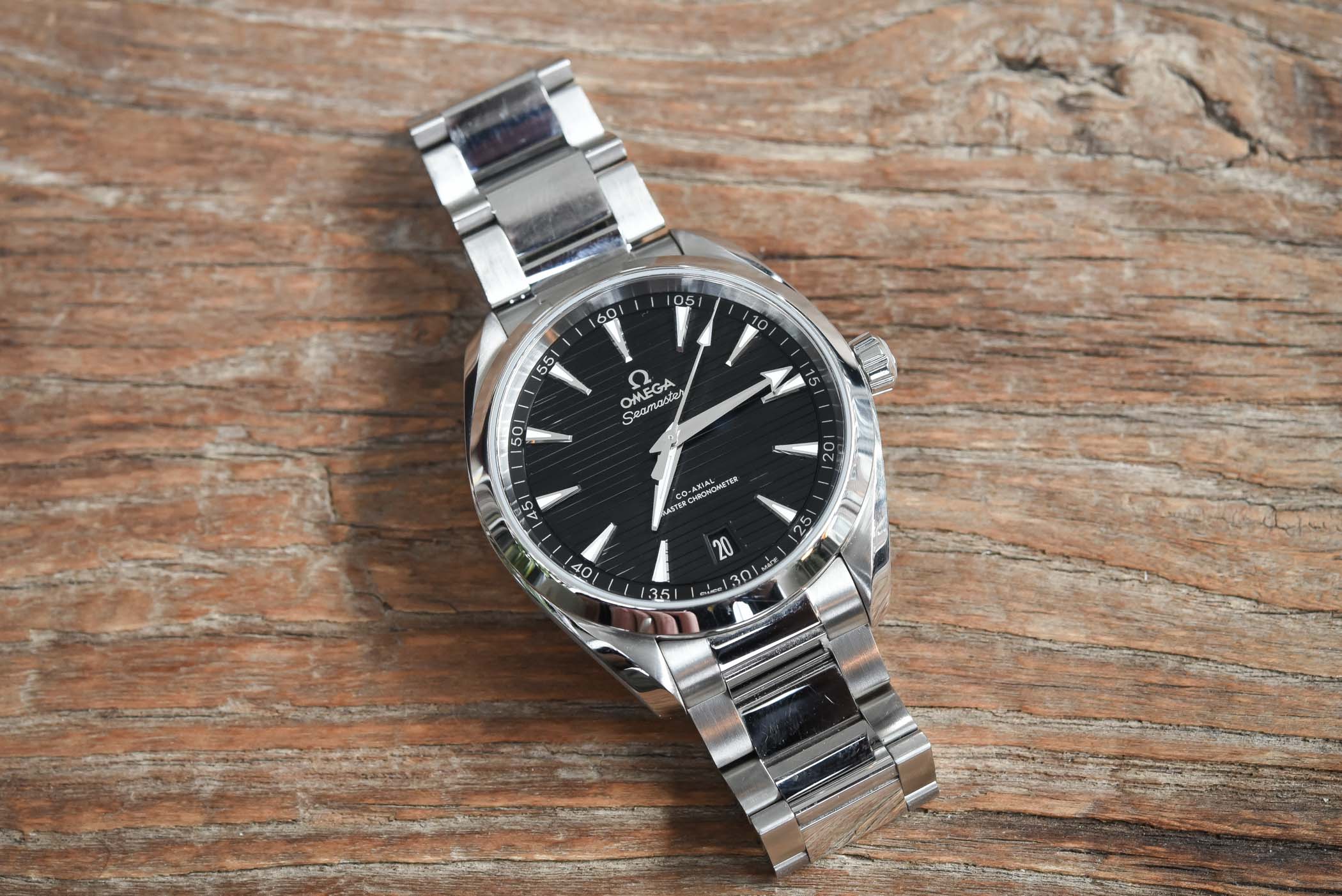

The Seamaster Aqua Terra
Launched in 2002, the Seamaster Aqua Terra had more of a casual, all-rounder aesthetic (in the vein of the 1948 original Seamaster) and was considered Omega’s answer to the Rolex Datejust. It used the COSC-certified, coaxial calibre 2500 automatic and initially only came on a leather strap. Not exactly a traditional dive watch, but it did carry the Seamaster name and a water-resistance rating of 150 metres, so you could dive if a rotating bezel wasn’t needed. It was revised in 2008 with a more interesting dial (from matte to vertical grooves) and again in 2013 with the METAS-certified calibre 8505 with a magnetic resistance of 15,000 gauss. Daniel Craig’s Bond wore an Aqua Terra in 2012’s Skyfall. In 2017, the date moved from 3 to 6 o’clock, and the dial’s vertical grooves were now horizontal. Because, why not? Calibre 8800 also brought an increased power reserve of 70 hours. Another update came in 2021 that added small seconds at 6 o’clock.
2005 – 2011 – The Seamaster Planet Ocean ref. 2200.50.00
A quick disclaimer: To keep things at a comfortable length, this will mostly focus on standard editions, dials and colours moving forward, as there’s a wide range of dials/styles and materials within the overall collection. The Seamaster Planet Ocean is again analogous to Rolex’s Sea-Dweller – a more diehard dive watch (over the more mainstream Seamaster Diver 300M) that’s arguably overkill for the vast majority of buyers. There was a choice of 42mm or 45.5mm case sizes, so those with smaller wrists weren’t overwhelmed with a massive timekeeper, although that’s still larger than the original 40mm Sea-Dweller from 1967 (ref. 1665). Thickness was substantial, starting at 14.5mm in height for the 42mm case and going to 17mm for the 45.5mm option. There was a domed sapphire crystal with particularly effective anti-reflective coatings and a solid caseback with an embossed seahorse (the Hippocampus). The hour and minute hands with Super-LumiNova were unusual as both had arrowhead tips, and even the seconds hand had an arrow(ish), spearhead tip. It’s most common to have just one main arrowhead hand on a watch.

 Image by Zeitauktion
Image by Zeitauktion
As indicated by its name, the Omega Planet Ocean had 600 metres of water-resistance at launch time, and although impressive, it seems a bit moot as 40 metres is generally the deepest descent for scuba divers. In fact, the record is 332.35 metres. It was set by Ahmed Gabr in 2014 and required multiple divers, very specialised gear and specific gas mixes, not to mention careful decompression techniques. Very few would attempt to repeat such a feat. His watch of choice was the Charmex CX Swiss Military 20,000 Feet Diver. While the Sea-Dweller had a standard “automatic” helium escape valve, the Seamaster Planet Ocean followed the Seamaster Diver 300M with a manual counterpart at 10 o’clock. As mentioned, it required the user to first unscrew the “second crown” for gas to escape.


image by Lepage.fr


image by Lepage.fr
There were a few initial aesthetic options for the 2005 Seamaster Planet Ocean, starting with the aluminium bezel insert, which was either black/silver or orange/black – the latter being the most emblematic design. Interestingly, 1/3 of the inner bezel was untreated silver aluminium, forming a distinctive ring. Arabic numerals at 12, 6 and 9 o’clock on the matte black dial were white with the black bezel and reddish orange with the orange bezel, although the orange numerals could also be had with the black bezel. Applied indices with Super-LumiNova inserts and an applied logo were the same on all configurations. A black date window sat discreetly at 3 o’clock. Strap options included leather, rubber or a model-specific bracelet with signature curved top surfaces.

 Images above and below by secondmovement.com
Images above and below by secondmovement.com
Powering the first generation was the C-version or third generation of calibre 2500, which was an ETA 2892-A2 modified with Omega’s Co-Axial escapement (same as Daniel Craig’s Seamaster Diver 300M from Casino Royale the following year). A Co-Axial escapement uses three pallets that separate the locking function from the impulse, unlike two pallets with the more conventional lever escapement. This greatly reduces sliding friction for less wear, longer service intervals (up to double that of earlier movements with lever escapements) and better overall accuracy, and was first seen commercially in 1999 with Omega’s De Ville. The C-version also went to a slower beat rate of 3.5Hz from the B-version’s 4Hz.
2008 – James Bond Special Edition, ref. 222.30.46.20.01.001
Omega and James Bond are as tied together now as Rolex was in the past. Not only were several models featured in the movies, but some became special editions for consumers. An example is the Seamaster Planet Ocean with a Quantum of Solace theme. Quantum of Solace is printed on the dial just under the hands, and the black dial itself is textured to mimic the grip of Bond’s Walther PPK. The 007 logo is also engraved on the caseback and bracelet’s buckle. This particular model used calibre 2500 as it’s from the first series in 2008.


2009 – Limited Edition Seamaster Planet Ocean Liquidmetal ref. 222.30.42.20.01.001
Liquidmetal doesn’t refer to the case (or T-1000 from Terminator 2), but the metal seamlessly blended with the new ceramic bezel insert. This reference is considered somewhat of a transitional model and was limited to 1,948 pieces (the year of the Seamaster). A titanium alloy was pressed into the ceramic bezel’s engravings to seamlessly form metallic Arabic numerals and marks that were perfectly flush and resilient. The matte black dial was now a glossy Zr02 ceramic with white gold applied indices, an applied logo and OMEGA, and orange printed Seamaster for a more upscale aesthetic. Calibre 2500 from the original model was carried forward, which might seem like a bad thing, but it was still a high-end workhorse with Omega’s Co-Axial escapement and notably kept the case thickness at 14.5mm, which notoriously got thicker after this model.


Ref. 222.30.42.20.01.001 sold at a premium over ref. 2200.50.00 (approx. USD 2,000) given the new bezel and dial, and is among the most collectable today and considered by many to be one of the best of the Seamaster Planet Ocean models.
2011 – 2015 – Seamaster Planet Ocean Second Generation ref. 232.30.42.21.01.001
The Liquidmetal ceramic dial became a permanent mainstay, but a lot changed with the second-generation model. For starters, a third case diameter was introduced – 37.5mm (a ladies’ model) along with 42mm and 45.5mm – while blue and white bezel and dial colours were added. Grade 5 titanium was introduced as a case option as well, so the Seamaster Planet Ocean really started to branch out. Classic black dials were matte like the first-generation model from 2005, but titanium models with a blue dial/bezel were glossy, which soon became standard across all models over matte (with later exceptions). A titanium bracelet was also an option for the blue model. Looking at the dial itself, changes included larger applied indices and the Omega logo, and the orange Seamaster from the 2009 limited edition model remained. Super-LumiNova had a blue glow everywhere except the minute hand and bezel pip, which were green at night.

 Image by subdial.com
Image by subdial.com
Powering the second-generation Planet Ocean was the in-house calibre 8500, which was labelled as a Co-Axial Chronometer and included a silicon hairspring. This replaced the earlier calibre 2500 with an ETA base and had 39 jewels, the same 3.5Hz frequency as the C-version 2500 and a power reserve of 60 hours via two barrels. Interestingly, the hour hand could now be set independently as well in one-hour increments. Calibre 8500 was first used in 2007 in the De Ville Hour Vision, but gained the silicon hairspring in this Planet Ocean. The new movement necessitated a thicker case, so the 37.5mm model was 15mm, the 42mm model was 15.7mm, and the 45.5mm case was 16.5mm (approx. the same as the earlier 45.5mm model).


The most mainstream 42mm case had the most dramatic increase at 15.7mm thick, while a comparable Sea-Dweller at the time was 14.5mm thick. Another significant upgrade was the switch from a solid to exhibition caseback, so the latest in-house calibre 8500 was on display with its signature swirled Geneva stripes.
2013 – Seamaster Planet Ocean GMT ref. 232.30.44.22.03.001
This model trades the diver’s bezel for a rotating 24-hour counterpart, so technically it’s not a dive watch (although, of course, it’s still more than capable and maintains 600 metres of water-resistance). “Professional” was replaced with “GMT” on the dial to emphasise the reduced credentials, as a proper bezel is vital for diving. The 24-hour bezel was ceramic, but curiously did not feature the Liquidmetal markings from earlier divers. The case size fell between the 42mm and 45.5mm standard models at 43.5mm in diameter and approx. 17.2mm in height. Unlike prior models, this one didn’t have a titanium option and came in either steel or 18k gold with a rubber strap or matching bracelet. Compared to the original Seamaster GMT released in 1998, which was 41mm in diameter and 13.4mm in height, the Planet Ocean GMT was significantly larger (although the 1998 model had half the water-resistance at 300m).

 Image by vanwonderenwatches.com
Image by vanwonderenwatches.com
This is a True GMT watch with an independently set hour hand and fourth GMT hand, Arabic numerals at 12, 6 and 9 o’clock, with a date at 3 o’clock. It used Omega’s in-house calibre 8605, which was a modified calibre 8500 from the second-generation diver to include full GMT functionality. It had 38 jewels, beat at 3.5Hz and again featured a 60-hour power reserve, and was also used in Omega’s Aqua Terra GMT.
2013 – The Seamaster Planet Ocean GMT GoodPlanet Foundation Edition ref. 232.30.44.22.03.001
Breaking the rules a bit from my earlier disclaimer, I’m going to discuss a couple of significant special editions. Following a 2011 partnership with the GoodPlanet Foundation, which highlighted good environmental stewardship (and they presented a joint documentary, Planet Ocean), Omega released the Planet Ocean GMT GoodPlanet Foundation edition. This mainly brought aesthetic tweaks to the current blue dial and bezel model with new orange bezel markings and an orange GMT hand. It used the same calibre 8605 as the standard model and only came in steel.
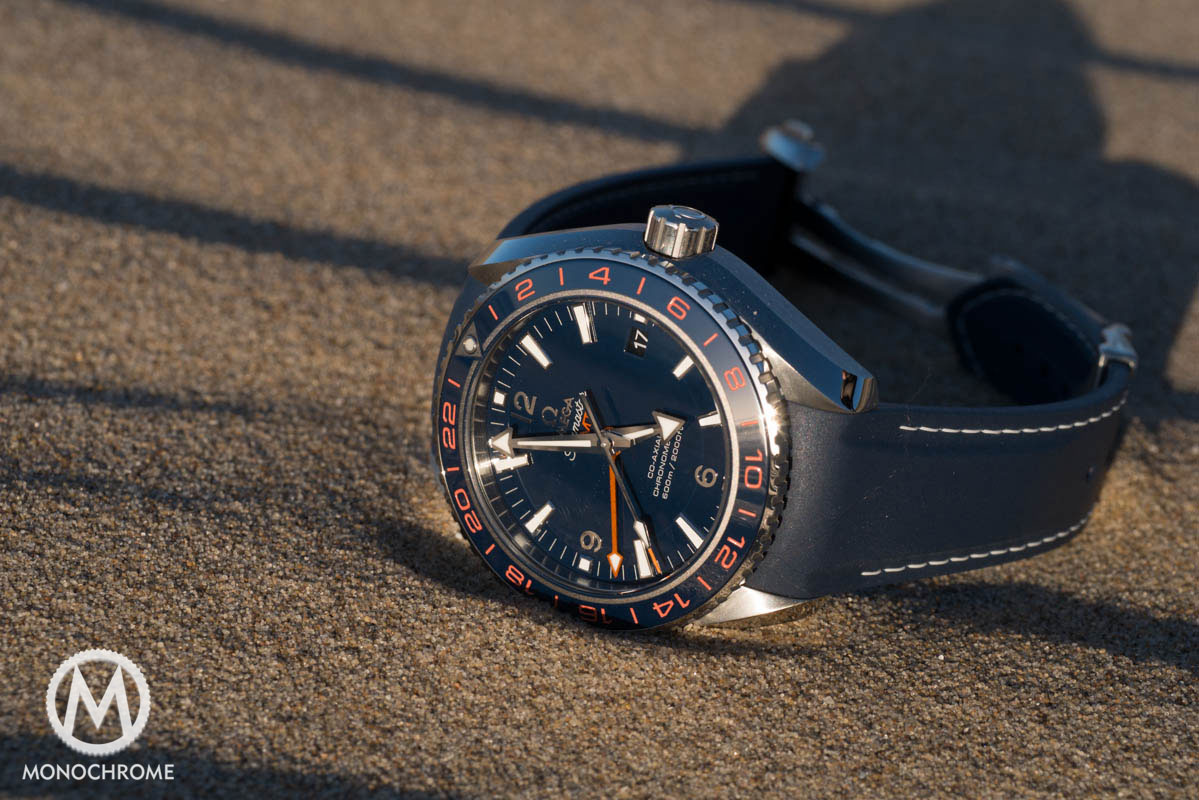

2014 – The Seamaster Planet Ocean Sochi Winter Olympics ref. 522.30.46.21.01.00
Omega has experience with Olympic Games, and two variants were made with a men’s 45.5mm case with bracelet and a ladies’ 37.5mm case with leather strap. Visual changes were relatively minor compared to the standard second-generation 45.5mm diver with new red and blue markings on the first 10 minutes of the bezel, with the last five in silver/white (colours of the Russian flag). The exhibition caseback was also solid on this one with a Sochi 2014 logo engraved. Unsurprisingly, these were limited to 2,014 pieces. The smaller ladies’ model had a silverish-white dial and bezel with the same blue and red bezel marks for 10 minutes and silver/white for five. However, the dial went further with a red Arabic 6 and blue Arabic 9 numeral. The ladies’ model had calibre 8520 to accommodate the smaller case with a comparable solid caseback as the 45.5mm model. There was also a PyeongChang 2018 limited edition three-hander in 2018.
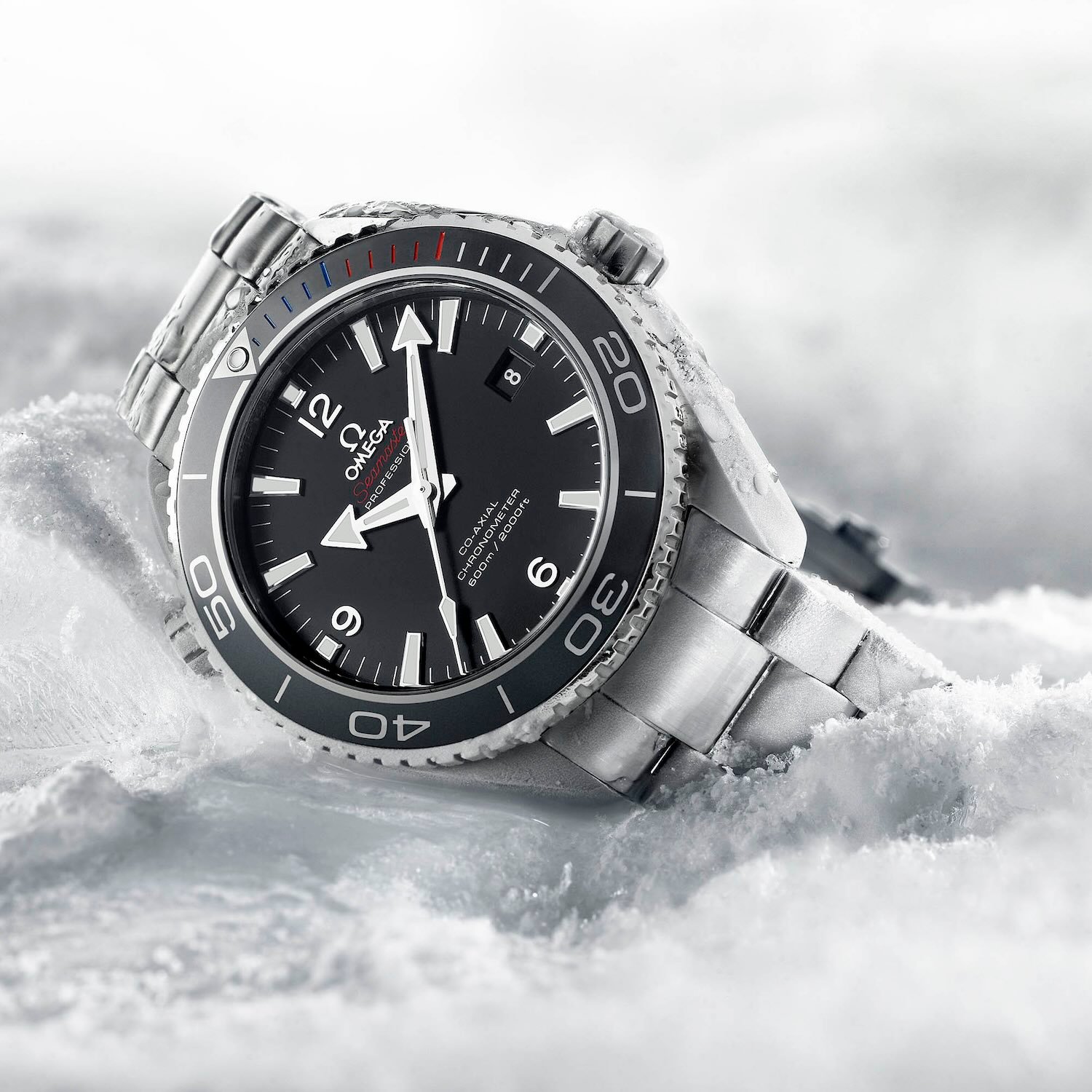



2014 – Seamaster Planet Ocean GMT Platinum, ref. 232.93.44.22.99.001
In the same year, Omega introduced a very limited Planet Ocean GMT with a ceramic orange bezel and platinum Liquidmetal marks. Prior to this, all orange bezels were aluminium as it was nigh impossible to incorporate the colour into ceramic (as in ALL orange bezels, not just within Omega, so this was a first for the industry). The model was limited to just eight pieces, and the case was platinum for a real statement piece. It displayed the Omega calibre 8615 automatic GMT with a solid gold rotor through a sapphire exhibition caseback. The dial was platinum in colour and featured orange Arabic numerals at 12, 6 and 9 o’clock and an orange GMT hand, and either leather or rubber in orange were strap options.
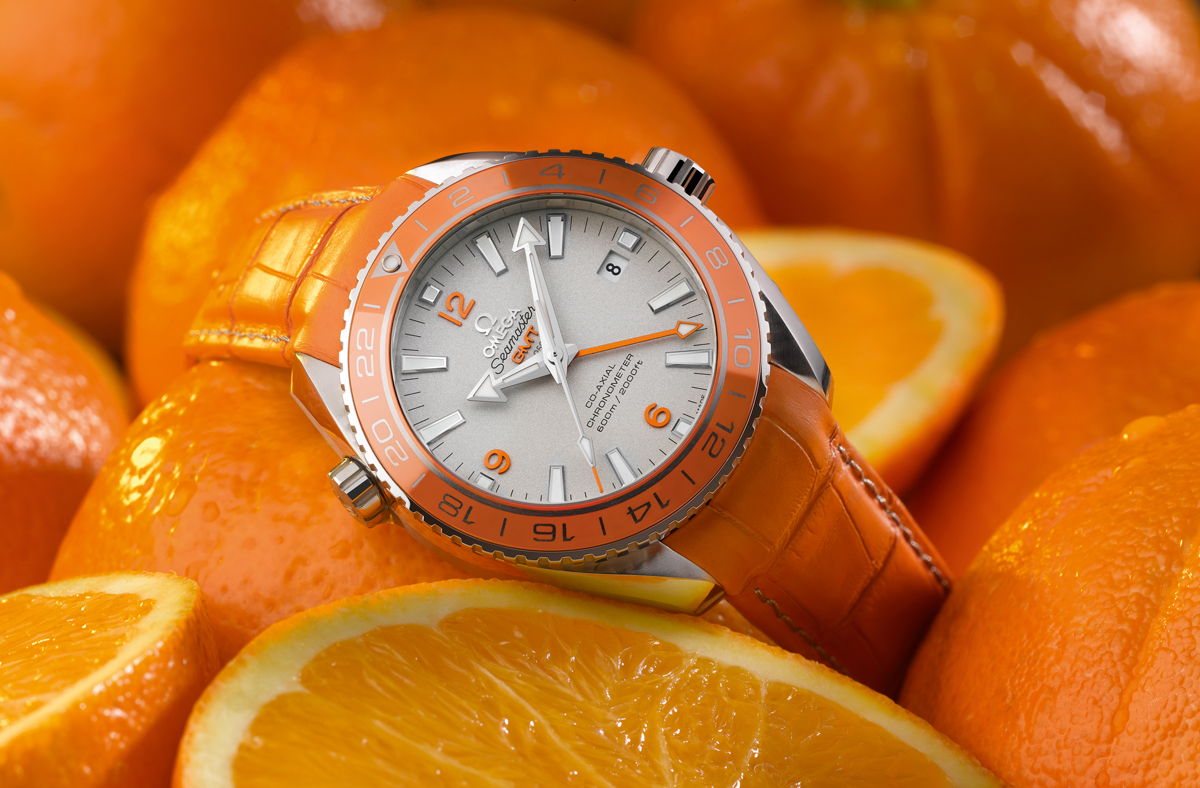

2016 – Present – Seamaster Planet Ocean Third Generation
A cool change with the third generation was the combination of liquid metal and orange vulcanised rubber within the ceramic bezel. The rubber section (on the 15-minute scale) provided a bright yet matte orange that really popped visually. As far as the dial (standard black dial and steel case), only a couple of things changed – new applied Arabic numerals and a slightly updated outer minute track. The Arabic numerals were orange at 12, 6 and 9 o’clock, along with the tip of the seconds hand. A very faint, black Zr02 inscription below the hands confirmed the ceramic, and the dial was polished ceramic like the bezel. A dial-matching date window sat at 3 o’clock. A new rubber strap was also introduced that had a texture to mimic fabric, and the clasp now offered micro-adjustments to 9.6mm. That coupled with the new bezel aesthetic, made a bigger difference than it might sound like on paper.
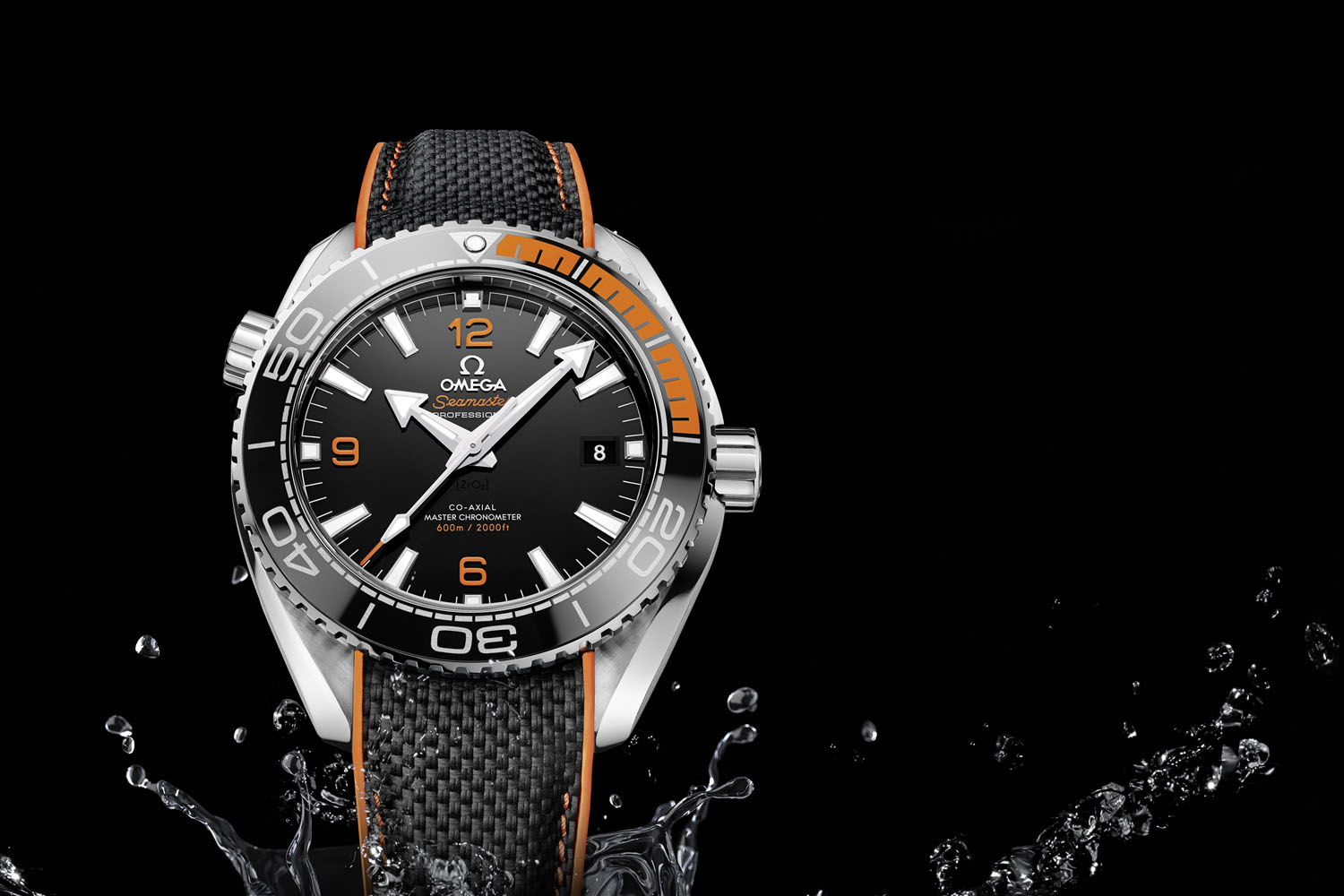

For the standard three-hand models, the case sizes changed – 37.5mm, 42mm and 45.5mm were replaced with 39.5mm and 43.5mm, which arguably better met the tastes of most consumers (particularly with the 39.5mm change). Other Planet Ocean models retained the larger 45.5mm case, like the chronographs. Along with stainless steel and titanium, there were options in rose and white gold. As far as case thickness, the 39.5mm came in at a slender (for the model) 14.2mm, while the 43.5mm case was bulkier at approximately 16.5mm.
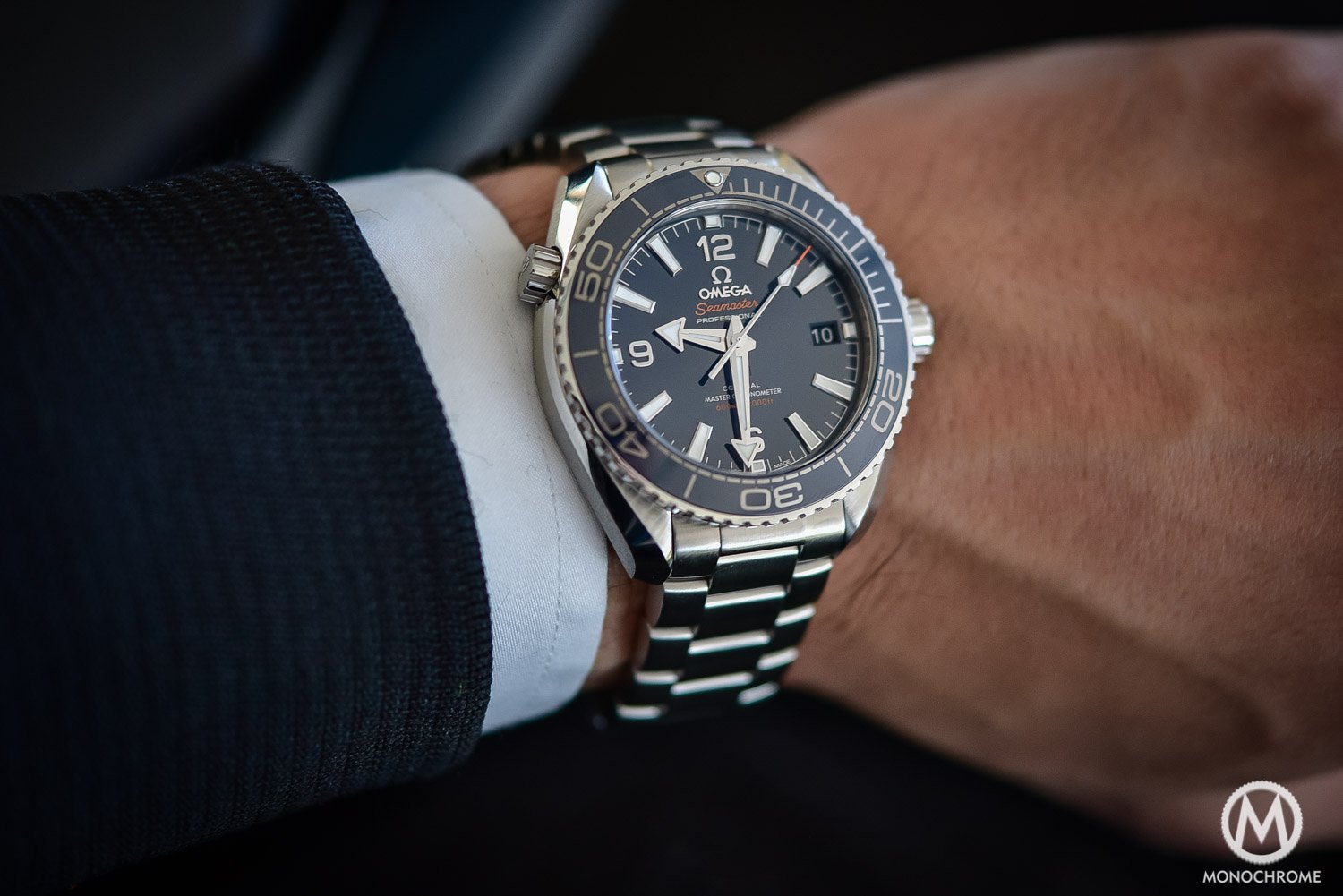

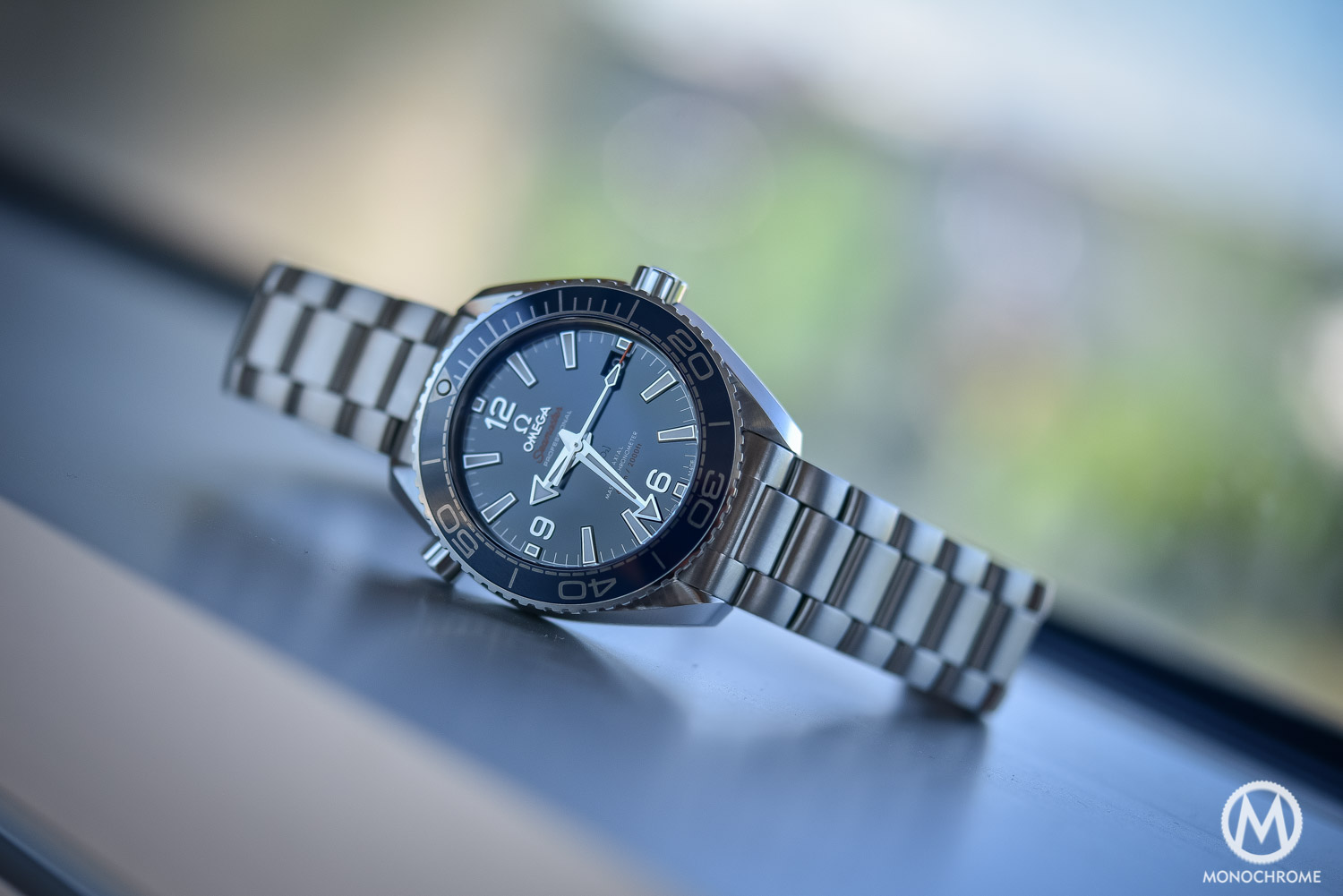

The biggest overall change was the upgrade to calibre 8900, which carried Omega’s Co-Axial METAS Master Chronometer certification as set by the Swiss Federal Institute of Metrology (METAS) in addition to COSC. This not only certified accuracy and performance (0/+5 seconds per day), but also magnetic resistance up to 15,000 gauss. It was introduced in 2015 for the Globemaster and was Omega’s first METAS calibre. However, the 39.5mm model had calibre 8800, which had a lower power reserve of 55 hours via one barrel compared to 60 hours on calibre 8900 with two barrels (same as calibre 8500). It also lacked the ability to jump the hour hand, but was still a METAS-certified Co-Axial Master Chronometer, which is arguably most important. Decorations on both included the swirled Geneva stripes, and the rotor engraving was updated to “Omega Master Co-Axial”.
2016 – Present – Seamaster Planet Ocean Deep Black GMT and Chronograph
Following the third-generation release, Omega introduced the Deep Black collection with 45.5mm ceramic cases (very thick at 17.8mm), expanding from the ceramic bezels and dials (zirconium dioxide – Zr02). This was first seen on the Speedmaster Dark Side of the Moon from 2013. Although large, the cases are significantly lighter than stainless steel. There were four models launched with red or blue accents, gold accents or all black. The screw-down casebacks also feature Naiad lock, which is a ceramic back that keeps lettering and other graphical elements aligned with the case for those of us with OCD. It’s also the first ceramic case to have a screw-down ceramic back, as Omega’s material has a bit of elasticity (ceramic is notoriously brittle for a ceramic-to-ceramic screw-down application).
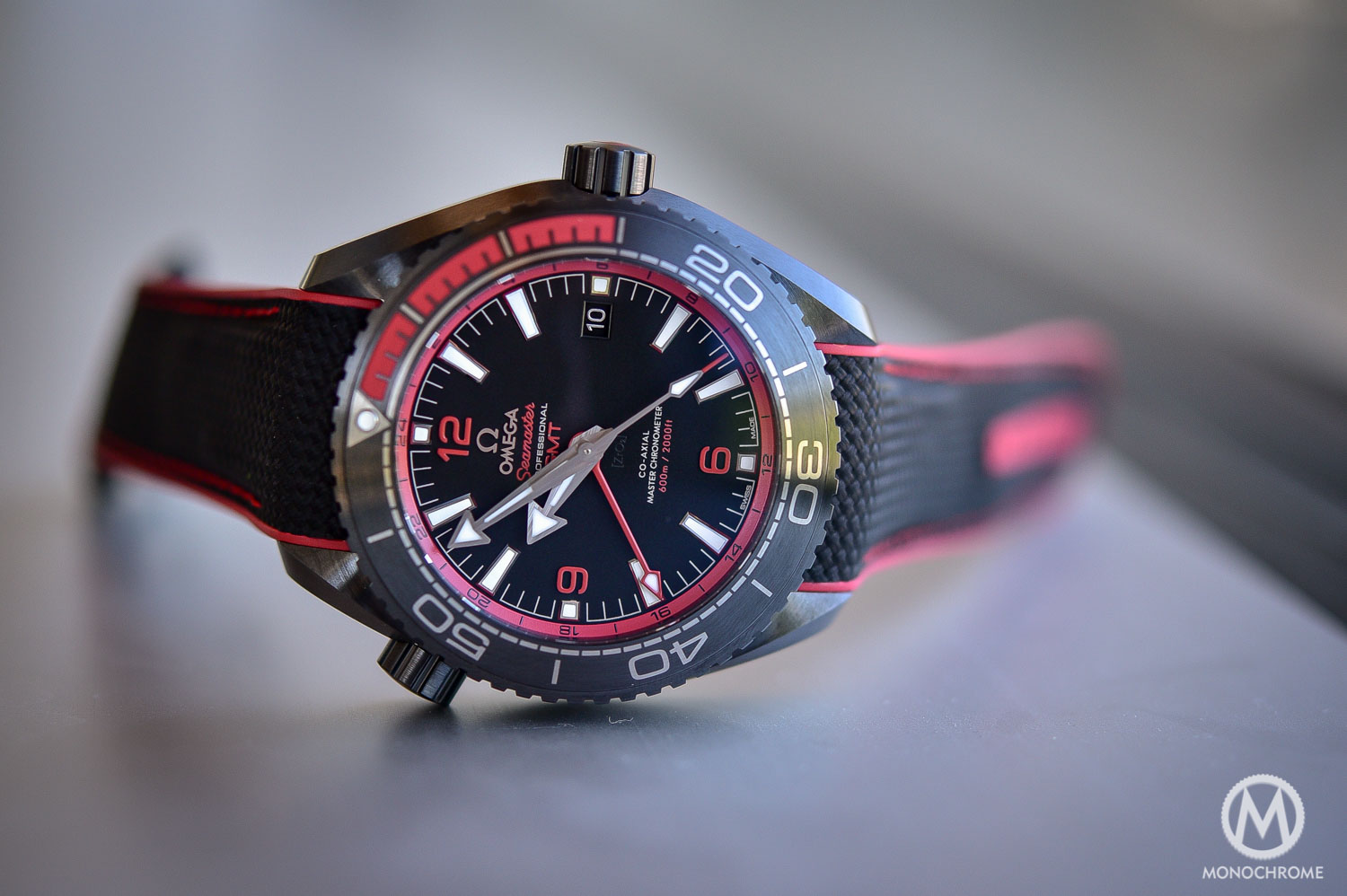

The priciest of the Deep Black collection includes accents in an 18k gold alloy called Sedna gold, which was used on the bezel in lieu of Liquidmetal (which was reserved for the other models). The blue and red models mix Liquidmetal with colour-matching vulcanised rubber for the 15-minute scale as seen on the third-generation models. The black ceramic dials are mirror-polished on the black and Sedna gold models, which also have polished areas of the case, but the red and blue counterparts have matte dials and cases. A year later, Planet Ocean Big Blue debuted with a blue ceramic case. A GMT ring sits inside the rotating diver’s bezel (instead of there being a 24-hour bezel), so these remain fully functional dive watches, unlike the original GMT models from 2013.


Powering the Deep Black GMT models is the calibre 8906 Master Co-Axial Chronometer, which is the GMT variant of the 8900. There are currently Deep Black chronograph models as well, with calibre 9900 Master Co-Axial Chronometer, introduced in 2016 and Omega’s first METAS chronometer movements. Ref. 215.92.46.51.01.001 has orange rubber in the 15-minute scale, a 12-hour counter at 3 o’clock, date at 6 o’clock and small seconds at 9 o’clock on a matte black ceramic dial. The chrono pushers also have complementing orange tubes. Ref. 215.92.46.51.01.003 is a black and turquoise chronograph that honours the Emirates Team New Zealand’s kiwi crew that defended the 37th America’s Cup 2024 yacht race. A turquoise countdown indicator at 3 o’clock replaces the 12-hour counter as a nod to pre-race protocol.
2025 – Present – Seamaster Planet Ocean Deep Black Worldtimer
In 2025, Omega integrated a Worldtimer into the Planet Ocean Deep Black collection (with the black ceramic ZrO2 case), although this function has been used since 2017 in the Seamaster Aqua Terra. A pair of watches with many of the same attributes of other Planet Ocean Deep Black models (600m water-resistance, helium escape valve at 10 o’clock, traditional diving bezel, arrowhead hands, twisted lyre lugs and so on) comes with the ability to show multiple time zones simultaneously. An outer rotating ring with world cities and an inner counterpart with 24-hour time (in black and white to indicate day and night) work together to show time around the world (hence the name). Simply line up a city to the current time, and all cities are then aligned to their respective time. A world map lies in the centre on a Grade 5 titanium base dial, made with varnish and laser ablation.
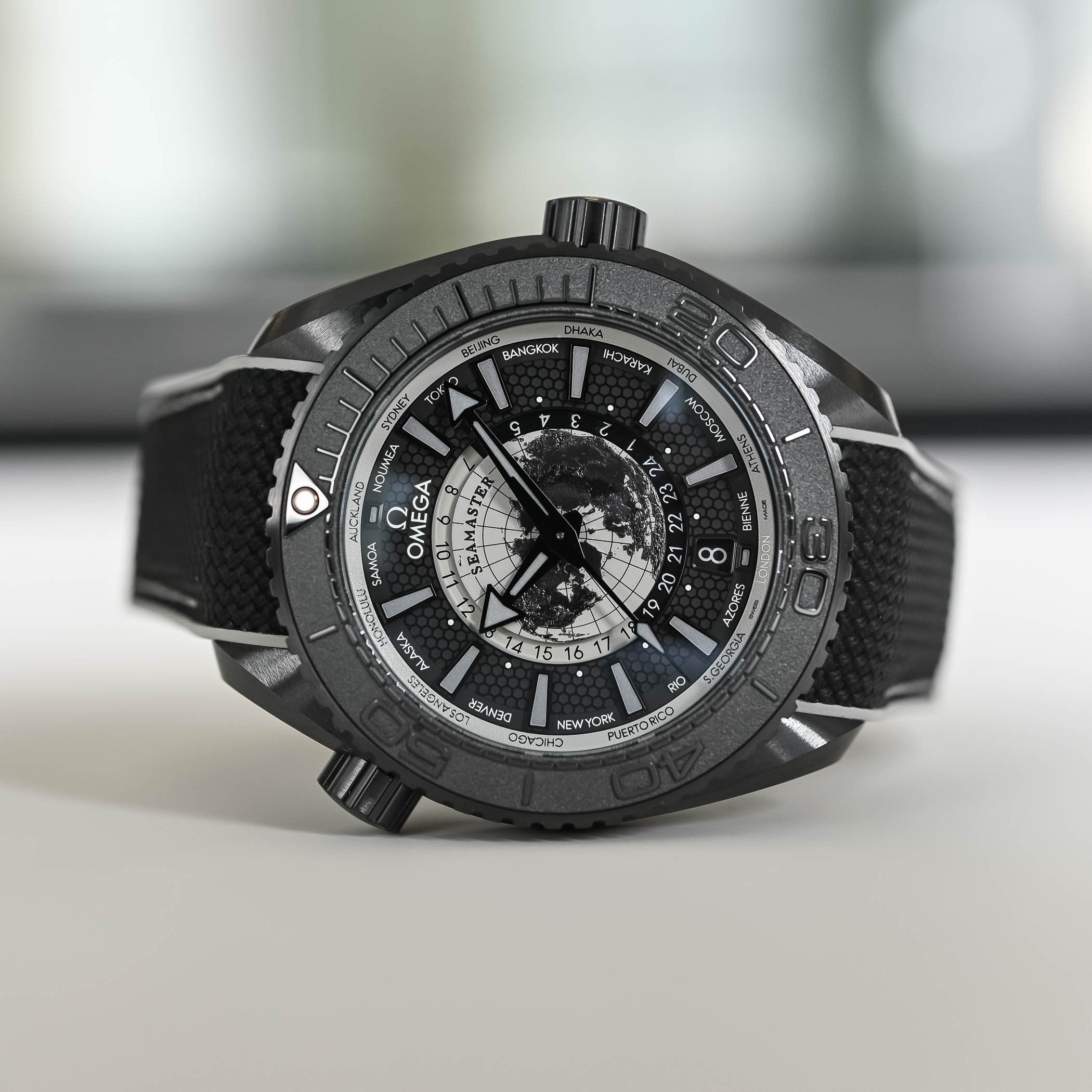

The ceramic bezel shows the dive markings in relief with the use of a laser, adding a cool detail not seen on the other Deep Black models. The two models are mostly separated by dial colours – one with turquoise elements (ref. 215.92.46.22.01.006) and one in monochromatic grey and black (ref. 215.92.46.22.01.007). Powering both is calibre 8938 that was used in the aforementioned Seamster Aqua Terra from 2017. It’s a METAS Master Co-Axial Chronometer and shares much with the other 89xx series with the addition of the worldtimer function, and is visible through the sapphire exhibition caseback with the familiar swirled Geneva stripes.
2022 – Present – Seamaster Planet Ocean Ultra Deep
Although this model debuted in 2022, it was 2019 that saw its appearance as a prototype with a deep dive record. Victor Vescovo took a submersible (the Limiting Factor submarine) down 10,928 meters (6.79 miles) in the Mariana Trench and broke a world record for the deepest dive, and the concept Omega Ultra Deep was attached to the side. Similar in concept to the Rolex Deepsea Challenge, which also had a prototype descend to extreme depths on James Cameron’s submersible before commercial availability, Omega’s Planet Ocean Ultra Deep became a buyable watch three years after its record descent in 2022.
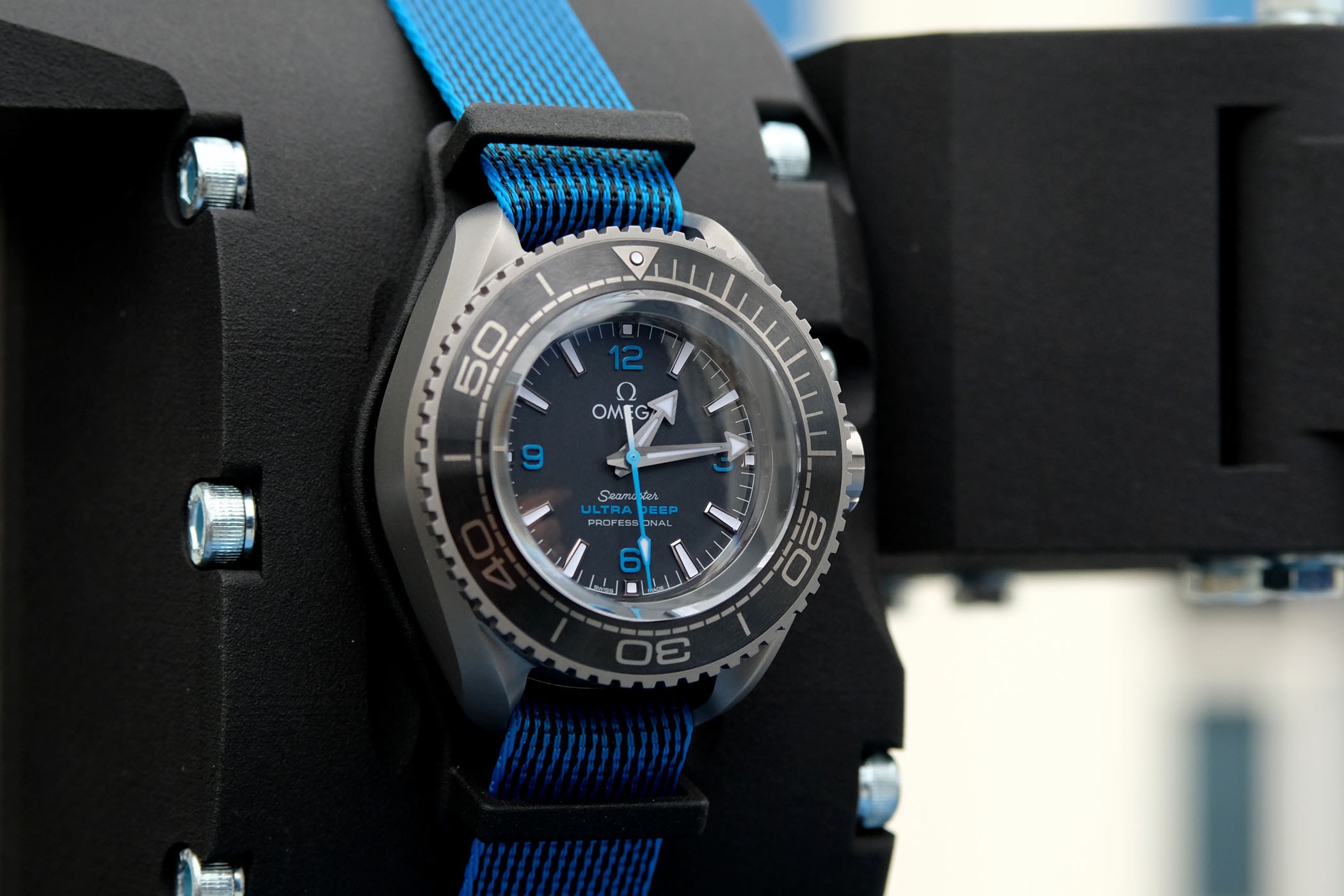
 The 2019 Ultra Deep prototype that broke the record with Victor Vescovo
The 2019 Ultra Deep prototype that broke the record with Victor Vescovo
The prototype measured 55mm x 28mm, so not exactly a wearable piece, but the production Planet Ocean Ultra Deep came in at a palatable 45.5 x 18.1mm with an optional lightweight Grade 5 titanium case. With titanium, the lug-to-lug is a long 56mm with Manta Lugs that necessitate a NATO strap, and it sits very high on the wrist. To keep the watch at a reasonable (on paper) 45.5mm in diameter, water-resistance was reduced to 6,000 metres, so you can’t try to reach the Earth’s core via the Pacific Ocean, but it’s still beyond any meaningful capability below water.


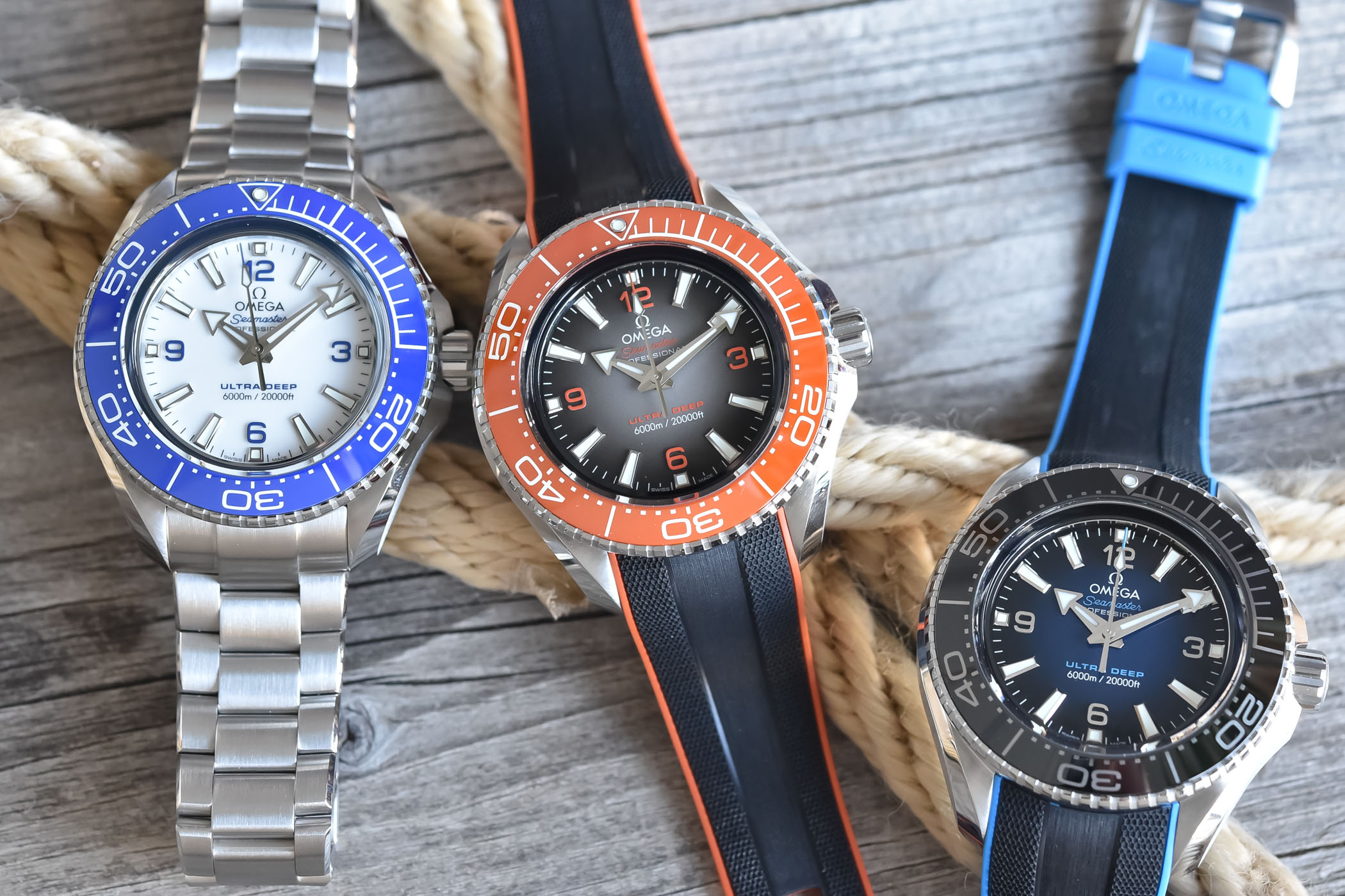

The titanium case is asymmetrical with a sandblasted finish that contrasts well with the brushed black ceramic bezel and matte black dial with blue Arabic numerals. There’s also a special stainless steel alloy model – O‑MEGASTEEL – with a bracelet that weighs in at 254 grams total (compared to 123 grams with titanium case and NATO strap). The steel case is round like other Planet Ocean models with traditional lugs, and the lug-to-lug is shorter at 51.95mm. It also features a polished bezel and polished case elements. The steel is stronger than 316L or 904L with a hardness of 300 HV (compared to 200 HV) as conventional stainless steel couldn’t withstand the extreme conditions. Even the crystal is special as it’s an Edge-Defined Film-Fed Growth (EFG) sapphire crystal with a unique shape and lack of even the tiniest of imperfections that can fail under the massive pressure. The case is so tough and impervious that a helium escape valve isn’t needed, as helium simply can’t enter the watch. There are multiple dial and bezel colours available, along with strap options and a bracelet.
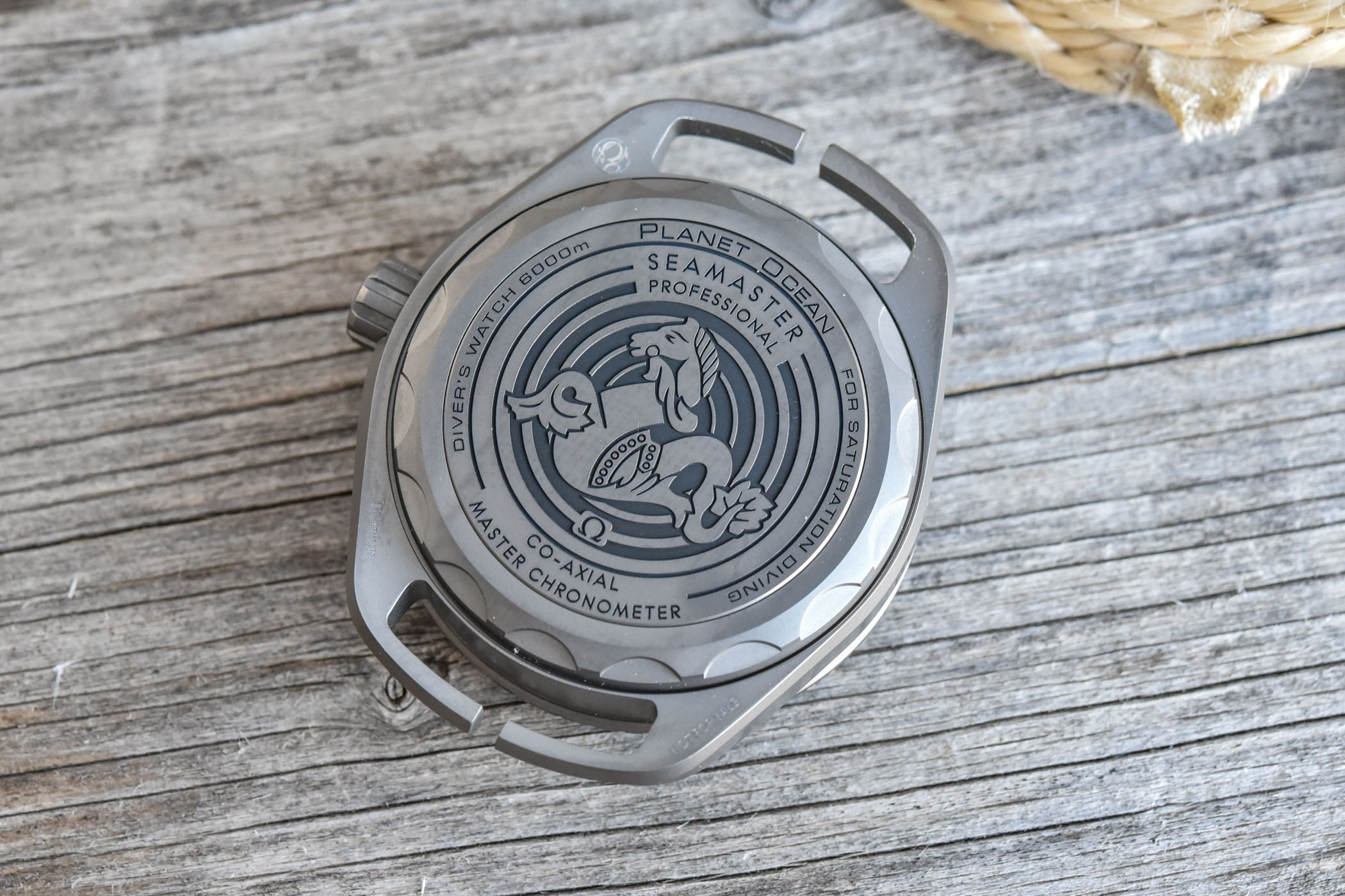

Powering the Planet Ocean Ultra Deep is the calibre 8912 Co-Axial Master Chronometer, which is a true no-date movement. Like many Planet Ocean models, it beats at 3.5Hz with a 60-hour power reserve via twin barrels. METAS certification also guarantees magnetic resistance of 15,000 gauss, and there’s a Si14 balance spring. A jump hour feature has also been carried over from earlier models. This is the same calibre used in the prototype model from 2019.
Collectors’ view
Most of the Planet Ocean watches aren’t particularly collectable and easily found on the pre-owned market at attractive prices. There are exceptions, such as the Limited Edition Seamaster Planet Ocean Liquidmetal (ref. 222.30.42.20.01.001), although it can still be found in excellent shape for around USD 7,000. The rarest Planet Ocean (outside of the Ultra Deep prototype) is the Platinum model (ref. 232.93.44.22.99.001), limited to only eight pieces. I have yet to find one on the pre-owned market, so I can’t estimate a price (but it’s very high). The ones featured in James Bond movies often have a bit more appeal, along with the Deep Black models, but overall, a pre-owned Seamaster Planet Ocean from any year will be both attainable and relatively affordable. Even steel Ultra Deep models can be found in great shape for under USD 10,000, which can’t be said for Rolex’s Deepsea Challenge, which is several times the price on the preowned market.
https://monochrome-watches.com/history-of-the-omega-seamaster-planet-ocean-collection-2005-2025-20th-anniversary-in-depth-review/